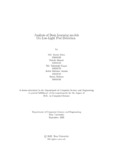| dc.contributor.advisor | Chakrabarty, Amitabha | |
| dc.contributor.author | Irtiza, Md. Samin | |
| dc.contributor.author | Ahmed, Fattah | |
| dc.contributor.author | Haque, Md. Tahmidul | |
| dc.contributor.author | Tamim, Arifur Rahman | |
| dc.contributor.author | Sultana, Samia | |
| dc.date.accessioned | 2023-10-16T07:43:04Z | |
| dc.date.available | 2023-10-16T07:43:04Z | |
| dc.date.copyright | ©2022 | |
| dc.date.issued | 2022-09-28 | |
| dc.identifier.other | ID 18101429 | |
| dc.identifier.other | ID 18101442 | |
| dc.identifier.other | ID 18101570 | |
| dc.identifier.other | ID 18101510 | |
| dc.identifier.other | ID 18101446 | |
| dc.identifier.uri | http://hdl.handle.net/10361/21848 | |
| dc.description | This thesis is submitted in partial fulfillment of the requirements for the degree of Bachelor of Science in Computer Science, 2022. | en_US |
| dc.description | Cataloged from PDF version of thesis. | |
| dc.description | Includes bibliographical references (pages 31-33). | |
| dc.description.abstract | It is undeniable that in recent years, exceptional progress has been made toward
building the most accurate and efficient object detectors. However, existing low-
light object detectors still require a substantial amount of resources to perform at
their best. Our main goal in this research is to train and evaluate recently developed
deep learning object detection models on low-light images and see if they can show
decent performance without any additional enhancement networks. Furthermore, we
aim to achieve those results with minimum computational cost. In this research, we
have created our own custom dataset from a publicly available insect image dataset
called ‘IP102’. The new dataset now named ‘IP013’ consists of 13 classes of insects
and approximately 8k annotated images. Moreover, we chose recently developed
YOLOv7 and DETR object detectors and compared their performance against now
older state-of-the-art RetinaNet and EfficientDet deep learning models. YOLOv7,
EfficientDet, and RetinaNet are purely CNN-based models whereas DETR uses a
Transformer as both encoder and decoder and a CNN as the backbone. Our research
shows that YOLOv7 outperforms all of the other models with a mAP0.5:.95 of 45.9
while using the lowest training time and the model that used the least computational
resources was EfficientDet which admittedly showed lackluster mAP0.5:.95 of 33.2
with only 3.9M parameters and using 2.5 GFLOPs. | en_US |
| dc.description.statementofresponsibility | Md. Samin Irtiza | |
| dc.description.statementofresponsibility | Fattah Ahmed | |
| dc.description.statementofresponsibility | Md. Tahmidul Haque | |
| dc.description.statementofresponsibility | Arifur Rahman Tamim | |
| dc.description.statementofresponsibility | Samia Sultana | |
| dc.format.extent | 43 pages | |
| dc.language.iso | en | en_US |
| dc.publisher | Brac University | en_US |
| dc.rights | Brac University theses are protected by copyright. They may be viewed from this source for any purpose, but reproduction or distribution in any format is prohibited without written permission. | |
| dc.subject | Low-light images | en_US |
| dc.subject | Enhancement network | en_US |
| dc.subject | Deep learning | en_US |
| dc.subject | Object detection | en_US |
| dc.subject | Insect | en_US |
| dc.subject.lcsh | Machine learning | |
| dc.subject.lcsh | Computer vision | |
| dc.title | Analysis of deep learning models on low-light pest detection | en_US |
| dc.type | Thesis | en_US |
| dc.contributor.department | Department of Computer Science and Engineering, Brac University | |
| dc.description.degree | B.Sc. in Computer Science | |

